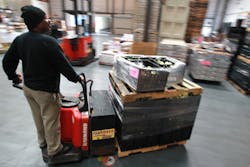If businesses look closely at one of their key performance metrics (injury statistics), what "weaknesses" would be revealed asks Kent Hatcher, director of business development for Humantech, a company that manages ergonomic in the manufacturing sector.
One weakness is the high number of injuries associated with manual material handling tasks (tasks that include lifting, lowering, pushing, pulling or carrying). Hatcher cites the 2014 Liberty Mutual Workplace Safety Index report that "overexertion involving outside sources" was ranked first among the leading causes of disabling injury in 2012, accounting for 25.3% of the overall national burden ($15.1 billion in direct costs).
Hatcher offers advice on how to reduce overexertion injuries.
The first step in the process, and the easiest in many cases, is to identify the "hot spots." You probably know where they are without investing a lot of time. If you don't, review your injury logs, ask employees for feedback, conduct formal surveys, identify production bottlenecks or perform the task yourself.
The equation – RWL = LC x HM x VM x DM x AM x FM x CM – is simpler than it appears. It uses six task variables and a load constant (LC) to establish a recommended weight limit (RWL). The RWL is the amount of weight that an employee can safely lift, given a specific job geometry, frequency and duration. This applies to 99% of men and 75% of women.
The LC is what the majority of the workforce can safely lift, given an absolutely perfect lifting scenario – for instance, the back is neutral, no twisting, no reaching, etc. – once a day. The load constant is 51 pounds (23.2 kg). Put another way, the equation will never recommend a RWL of greater than 51 pounds.
More on improving the material handling process on EHS Today.
EHS today is a companion site to MH&L within Penton’s Manufacturing & Supply Chain Group.
